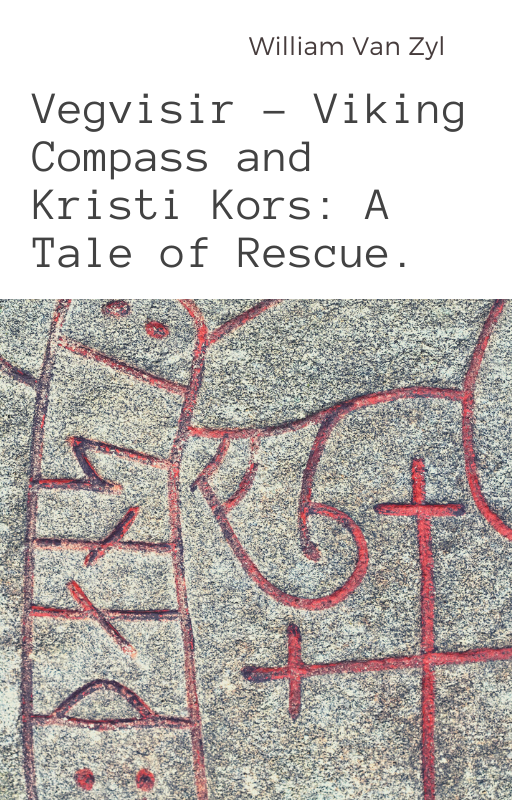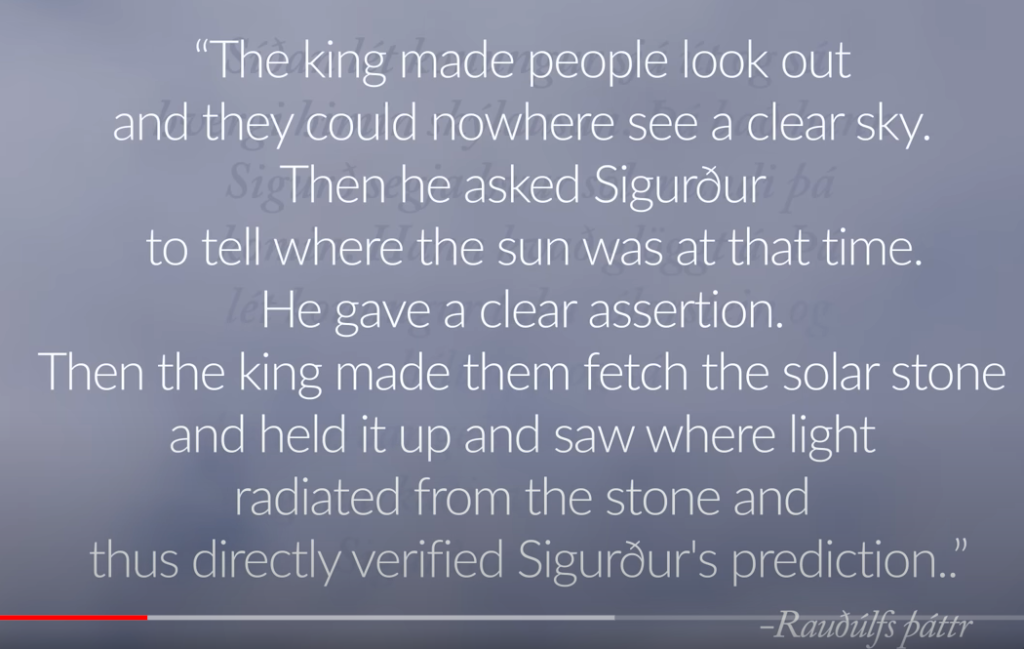

By William Van Zyl (Published in October 2023).
Have you ever been in a life-or-death situation? Have you ever been at a crossroad in your life? Are despondency and mental health issues plaguing you? Are you sick, have you received a devastating health report? Do you have to make a sacrifice?
The Vikings had a Runic Cross: An ordinary Vegvisir. Looked like a compass. It was the Emblem of Guidance and Protection. The pattern was intricately engraved on a stone or ring – a Talisman. The Vegvisir, alternatively called the runic compass or the Viking compass/Nordic compass, featured eight Viking rune staves and symbolised protection and guidance. Vikings are thought to have used this unique symbol as a compass during their journeys. In Iceland, the term “vegvisir” translates to ‘Wayfinder’ and ‘Signpost.’
I also touch on the Viking Sunstone as a practical navigation tool: When the sun was not visible, the Sunstone indicated where the sun was – very useful indeed.
I love all things Viking. For fun, I compare the Vegvisir and the Cross.
Table of Contents
Viking Sunstone:
The Vikings have also used a Sunstone for navigation. is a legendary navigation tool said to have been used by the Vikings during their voyages. It is believed to have aided them in determining the direction of the sun even when it was obscured by clouds or below the horizon. While there is some historical evidence to suggest the Vikings may have used such a tool, its exact nature and properties remain a subject of debate and mystery. See the video below for stunning details.

Credit: Symbolsage.com. Link: https://symbolsage.com/vegvisir-symbol-origins-and-history/

The Viking Sunstone.
I have pondered the differences between the Viking Compass and the Christian Compass – The Cross. I compare and contrast the two from my Christian writer’s voice for you.
Remember that Christianity eventually found its way into the Viking or Norse culture. The Christian Cross (Kristi Kors – in Norwegian) is embedded in their culture.
Viking Cross:
Many early Viking Christians have incorporated Christo into their cosmology rather than rejecting their old ways altogether. We find sayings in the sagas like, “On land I worship Christ, but at sea I worship Thor.” This was not apostasy – just what the pre-modern polytheistic mind considered pragmatic.

An enkolpion, a relic box formed as a crucifix from the Viking age, found in Uppåkra, near Lund, Sweden; Museum of History in Lund. Credit: https://en.wikipedia.org/wiki/File:Viking_age_christian_cross_found_in_Lund_sweden.jpg
Comparing and Contrasting the Christian Compass and the Runic Compass (Viking Compass)
The Christian Compass (Kristi Kors):
- Symbolic Focus:
- Cross of Christ: The Christian Compass is often symbolised by the Cross of Christ, a central and sacred emblem in Christianity representing the crucifixion and resurrection of Jesus.
- Spiritual Foundation:
- Christianity: The Christian Compass is deeply rooted in Christian spirituality, emphasising faith, salvation, and the teachings of Jesus Christ as a guide for moral and ethical living.
- Navigational Symbolism:
- Spiritual Direction: The Christian Compass serves as a metaphorical guide for Christians, directing them spiritually through life’s journey by following the principles of their faith.
- Cultural Significance:
- Christian Tradition: The Cross of Christ and the Christian Compass are integral to Christian religious practices, rituals, and traditions, influencing art, architecture, and various aspects of Western culture.
The Runic Compass (Viking Compass):
- Symbolic Focus:
- Vegvisir: The Runic Compass, often represented by the Vegvisir, is a symbol with eight runic staves and is associated with protection and guidance. It has mystical and spiritual significance in Viking culture.
- Spiritual Foundation:
- Norse Mythology: Thunic Compass is rooted in Norse spirituality and mythology, reflecting the Vikings’ connection with the natural world, deities, and the unseen forces that influenced their lives.
- Navigational Symbolism:
- Navigational Aid: The Runic Compass was a practical navigational tool for Vikings during their seafaring voyages. It was believed to guide sailors through storms and ensure a safe journey.
- Cultural Significance:
- Viking Heritage: The Runic Compass, especially the Vegvisir, holds cultural significance in Viking heritage and is associated with exploration, adventure, and the seafaring prowess of the Norse people.
Comparative Points:
- Spiritual Essence:
- Both compasses are symbols deeply embedded in the spirituality of their respective cultures—Christianity for the Christian Compass and Norse mythology for the Runic Compass.
- Navigational Purpose:
- While the Christian Compass primarily serves as a metaphorical guide for ethical living, the Runic Compass was a tangible tool used by Vikings for navigation during their maritime expeditions.
- Cultural Influence:
- The Christian Compass is deeply woven into Western cultural traditions through Christianity, while the Runic Compass is an emblem of Viking heritage, influencing Norse cultural practices.
Contrast:
- Religious Context:
- The Christian Compass is inherently tied to the monotheistic beliefs of Christianity, emphasising a personal relationship with a single God. In contrast, the Runic Compass reflects the polytheistic Norse worldview with multiple deities.
- Practical Application:
- The Christian Compass is primarily symbolic and metaphorical, guiding believers spiritually. On the other hand, the Runic Compass had a practical application as a navigational instrument for seafaring.
- Cultural Origins:
- The Christian Compass originates from the Judeo-Christian tradition, while the Runic Compass has its roots in Norse paganism and mythology.
In summary of the first section, these two compasses differ significantly in their cultural origins, spiritual foundations, and practical applications, highlighting the diversity of beliefs and practices in the Christian and Viking traditions.
Dear reader, what is your choice of a compass for navigating life?
Using the Cross of Christ as a navigation tool:
Navigating Life’s Journey: Using the Cross of Christ as Your Compass
In the tapestry of Christian symbolism, the Cross of Christ stands as an enduring beacon of faith, sacrifice, and redemption. Beyond its significance in religious ceremonies, the Cross can also serve as a profound compass for navigating the complexities of life. In this article, we explore how the Cross of Christ can be utilised as a guiding instrument for your journey through the twists and turns of life.
1. Embrace the Vertical Axis: Faith and Spirituality
- The vertical beam of the Cross represents the connection between humanity and the divine. Use this axis as a guide to deepen your faith and spirituality. Let your upward gaze remind you to seek a higher purpose, to cultivate a relationship with the Divine, and draw strength from the wellspring of spiritual nourishment.
2. Follow the Horizontal Beam: Relationships and Compassion
- The horizontal beam extends outward, emphasising our relationships with others. Just as Christ’s sacrifice stretched across the horizontal plane, let the Cross guide you to cultivate compassion, empathy, and love for your fellow human beings. Treat others as you wish to be treated, and let the Cross inspire a life marked by kindness and understanding.
3. Navigate Life’s Crossroads: Decision-Making
- Life is filled with crossroads, moments where choices shape our destiny. Turn to the Cross as your compass during decision-making. Consider the teachings of Christ as a moral guide, and let the principles of love, justice, and humility inform your choices. The Cross can remind you to make decisions aligning with your faith and values.
4. Find Redemption and Healing: Facing Challenges
- Just as the Cross symbolises redemption and healing, let it be a source of solace during challenging times. When faced with adversity, turn to the Cross for strength, resilience, and the assurance that even in the darkest moments, there is the promise of renewal and redemption.
5. Bear Your Cross: Embrace Sacrifice and Service
- In the Christian tradition, the concept of bearing one’s cross is a call to embrace sacrifice and service. Let the Cross inspire a life of selflessness, encouraging you to extend a helping hand to those in need. By bearing your cross, you participate in the transformative power of sacrificial love.
6. Celebrate Resurrection: Embrace Hope
- The empty tomb and the resurrection are central to the Christian message. Let the Cross guide you to embrace hope, even in the face of despair. Understand that, like Christ’s resurrection, there is the promise of new beginnings, growth, and the triumph of light over darkness.
Conclusion:
The Cross of Christ is not merely an emblem of religious identity but a profound compass that can guide you through life’s journey. By embracing its vertical and horizontal dimensions, navigating crossroads, finding solace in challenges, embracing sacrifice and service, and celebrating the hope of resurrection, you can use the Cross as a transformative and illuminating guide for a purposeful and meaningful life. As you travel the paths of your existence, let the Cross of Christ be your unwavering compass, directing you towards a life filled with faith, compassion, and enduring love.
Psalm 118:22-23, “The stone which the builders rejected has become the cornerstone; the LORD had done this, and it is marvellous in our eyes.”
This stone was left and carved around because ancient builders literally rejected it.
Interested to read more about the Vegvisir?
Copyright © 2023 by William Van Zyl
Vegvisir – Viking Compass and Kristi Kors: A Tale of Rescue.
All rights reserved. This eBook/article or any portion
thereof may not be reproduced or used in any manner
without the publisher’s permission, except for using brief quotations in a book review.
Published by Five House Publishing (New Zealand)
First Publishing, June 2023

More eBooks and articles are available at https://fivehousepublishing.com/
More about the author at http://williamvanzyl.com/